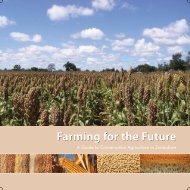Restoring the Soil - Canadian Foodgrains Bank
Restoring the Soil - Canadian Foodgrains Bank
Restoring the Soil - Canadian Foodgrains Bank
Create successful ePaper yourself
Turn your PDF publications into a flip-book with our unique Google optimized e-Paper software.
84Annex 2: The Evidenceseasonal winds called <strong>the</strong> “harmattan.” Thousands of tons of topsoil are carried across<strong>the</strong> sou<strong>the</strong>rn perimeter of <strong>the</strong> Sahara desert. To understand how much soil is moved,you only need to look at <strong>the</strong> windward side of many homes on <strong>the</strong> windward side ofSahelian villages. The build-up of topsoil against those walls is frequently over a metrehigh, and occasionally reaches <strong>the</strong> eaves of <strong>the</strong> house. In much of <strong>the</strong> Sahel, every lowlyingbush that has leaves year-round (including <strong>the</strong> nyama) has around 40 cm of soilbuilt up around its base. This represents a major transfer of nutrients from one field toano<strong>the</strong>r, and a major influx of phosphorus to fields in which farmers are using nyamaor o<strong>the</strong>r bushes to fertilize <strong>the</strong>ir soil.With <strong>the</strong>se dynamics as background, let’s return to <strong>the</strong> original question of <strong>the</strong>effect of organic matter on <strong>the</strong> availability of phosphorus. Our present methods ofsoil analysis do not give us a very good answer. Some scientists who have looked atphosphorus levels in organic systems have admitted <strong>the</strong>y cannot explain where all <strong>the</strong>phosphorus is coming from (Cheryl Palm is one of <strong>the</strong>m).CGIAR (Consultative Group on International Agricultural Research) system scientistshave been telling us for over a decade that Africa is heading for a major crisis of soilphosphorus deficiency. They have not been clear about exactly when <strong>the</strong> problemwould hit, but certainly sometime within <strong>the</strong> 25 years following <strong>the</strong> start of <strong>the</strong>irpredictions. They normally give two major reasons for decreasing levels of availablephosphorus. One is <strong>the</strong> gradually decreasing levels of available phosphorus <strong>the</strong>y havefound in <strong>the</strong> soil analyses <strong>the</strong>y’ve done. The second is a calculation based on cropyields, from which <strong>the</strong>y have calculated <strong>the</strong> annual loss to <strong>the</strong> soil of various nutrients.But <strong>the</strong>re is reason to believe that somehow more phosphorus is available to plantsthan scientific studies would indicate. The CGIAR calculation based on crop yieldsmay be based on a major misunderstanding of <strong>the</strong> dynamics of smallholder agriculturein Africa. In <strong>the</strong> United States, calculating nutrient losses on <strong>the</strong> basis of crop yieldscan be quite accurate because American farmers consume virtually nothing of what<strong>the</strong>y harvest, and even what <strong>the</strong>y do consume goes into flush toilets and far away from<strong>the</strong>ir farms. However, <strong>the</strong> vast majority of African smallholder farmers produce onlyenough food for 6 to 10 months of consumption. That is, most African villages arenet importers of food, and <strong>the</strong>refore net importers of phosphorus. Their food wasteall goes ei<strong>the</strong>r onto <strong>the</strong> soil surface or into hand-dug latrines that go nowhere near asdeep as some of <strong>the</strong> roots of nearby bushes and trees. So quite likely, <strong>the</strong> total amountof phosphorus recycled into people’s fields is even greater than <strong>the</strong> amount that istaken out at harvest time.That leaves soil analyses of available phosphorus as <strong>the</strong> main credible piece of evidencefor <strong>the</strong> predicted African soil phosphorus crisis. Remember, scientists point to graduallydecreasing levels of available phosphorus in soil analyses. But do decreased levelsof available phosphorus correlate well with decreased levels of <strong>the</strong> total phosphorus in<strong>the</strong> soil?<strong>Soil</strong> analyses, by and large, do not give us a very accurate assessment of <strong>the</strong> phosphorus
















